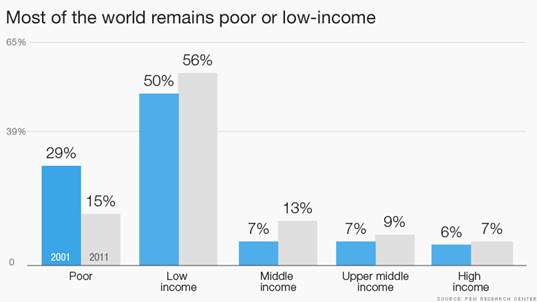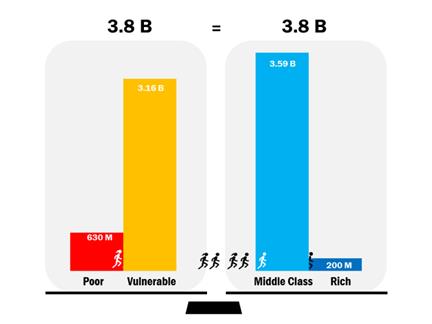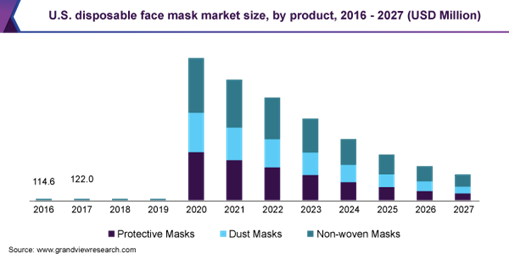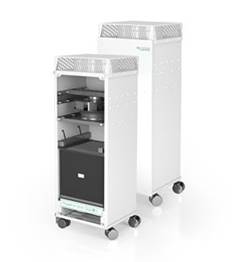
Coronavirus Technology Solutions
June 30, 2020
Who is Going to Need an Efficient Mask?
McIlvaine is Making and Continually Adjusting
Forecasts which are at Variance with Those in
Standard Market Reports
Annual Face Mask Market of
$40
billion to $400 billion
H&V Wins $2.2 million Mask Contract from DOD
One Million Meat Processing Workers in EU Need
PPE
Camfil has New Room Air Purifier
More Efficient Air Filtration Systems Needed for
New York Malls
______________________________________________________________________________
Who is Going to Need an Efficient Mask?
Most of the citizens of the world will need
efficient masks. Those in healthcare and certain
other occupations will need to spend much more
than will need to be spent on young children.
There are 43.5 million health workers in the
world, it is estimated that 20.7 million are
nurses and midwives. There are 3.8 million
registered nurses in the U.S. There are 2
million surgeons, anesthesiologists, and
obstetricians worldwide.
The world population is 7.8 billion. There are
close to 700 million children under 5 who may
need less spent to protect them.
In 2018 the number of people older than 64 years
old surpassed the number of children under 5
years old. The timing varied significantly
between countries – in higher income countries
with low fertility rates and longer life
expectancies, it has been shifting for decades.
In the United States, under-5s were already
outnumbered by those older than 64 by 1966. In
Spain it was 1970; in South Korea it was 2000.
For many countries, this crossover point is
still to come. In India, it’s projected to be
2028. In South Africa, it’s expected to happen
in 2036. In low-income countries with high
fertility rates and lower life expectancy this
point is still many decades away: it’s projected
that in Nigeria, under-5s will outnumber those
older than 64 until 2087.
The number of children under 5 years old is
projected to
peak and plateau for most of the 21st century.
And as the global population of people older
than 64 years will continue to grow, it’s clear
that we’re moving towards an ageing world.
Ten percent of the world or 780 million people
live on less than $700 per year. So the only way
they could afford masks is if they are provided
free of charge.

By 2018
there were as many middle income and rich people
as there were those with lower incomes.

The market for masks is a function not only of
ability to pay but need to prevent spread. It is
expected that the poorest people in the world
will be given a vaccine. In part this is because
the more wealthy people see that this as in
their best interest.
The same will be true for masks. If a vaccine is
not fully effective, we will need to distribute
efficient masks to most of the 7.6 billion
people in the world.
McIlvaine is Making and Continually Adjusting
Forecasts which are at Variance with Those in
Standard Market Reports
Current available market reports on Google
reflect a present mask market anywhere from a
few billion dollars to over 70 billion dollars
per year. All are forecasting the market to
shrink back to closer to its former size of a
few billion dollars per year. They forecast a
U.S. market which peaks this year and does not
take into account the new pressure for everyone
to wear masks.

|
World Face Mask Market - $ billions |
||
|
Forecaster |
2020 |
2025 |
|
Grandview |
70 |
20 |
|
Allied |
1.6 |
2.2 |
|
Market Study |
10 |
3 |
There is considerable difference in the
forecasts. Part is scope. But that does not
fully explain the differences. McIlvaine is
projecting a very large market well into the
future. So there is no correlation with some of
these other forecasters.
Annual Face Mask Market of
$40
billion to $400 billion
Efficient facemasks will be a primary weapon to
combat COVID. If all of the world’s 7.6 billion
citizens wore the equivalent of N95 masks when
in public places there would not be any virus
transmission. If everyone wore N80 masks 95% of
the transmission would be eliminated. If they
wore N30 masks 51% of the transmission would be
eliminated. Loosely fitting scarves and DIY
masks average only 10% reduction. These are
rough estimates but the Daily Coronavirus
Technology Solutions Alerts have extensive
analysis of these options.
Healthcare workers and others in high virus
environments should be spending more on masks
than those in less risky environments. There are
43 million healthcare workers of which 2 million
are surgeons who will need to change masks
frequently throughout the day.
The world is now split with 3.8 billion people
in the middle income or wealthy group. However,
since wealthy people will benefit from mask
wearing by poor people the ability to pay is
likely to be less of an obstacle.
There are lots of variables which will impact
the market size. There are others which will
impact the market share for different products.
Market size variables
·
Number of individuals at risk
·
Development of vaccines and therapies
·
Herd immunity
·
Funding for developing countries
·
Commitment to a solution
·
Related benefits such as prevention of other
outbreaks and protection against air pollutants
Market share variables
·
Meltblown
capacity
·
Development of nanofibers and other media
·
Efficiency requirements
·
Mask design
·
Reuse
·
Global cooperation
The ability of N95 masks worn by transmitter and
recipient to eliminate 99.75% of the virus and
for N80 masks to eliminate 95% are justification
for spending trillions of dollars per year for
masks. These straight forward calculations may
or may not be accepted by decision makers.
In any case there is newly developed consensus
that masks are a primary weapon to fight COVID.
As
result at least $40 billion will be spent
on masks in 2021.

However there is justification for a forecast as
high as $300 billion. If masks become a primary
weapon and are successfully employed the value
will be trillions of dollars per year in reduced
health costs and increased economic output
around the world.
There is the outside chance that COVID will
disappear by 2027 and the mask market could drop
below $40 billion. The odds are that it will
still be a threat although less of a threat than
at present.
So there is a wide range of possible
revenues in 2027.
So many developments are occurring each day that
it is necessary to compile them in the daily
Alerts and then continually revise forecasts.
These daily Alerts will help suppliers adjust
their sales programs as needed. They can use the
Coronavirus Technology Solutions as a
foundation.
McIlvaine can supplement this service
with customized forecasts for masks, media and
other products.
H&V Wins $2.2 million Mask Contract from DOD
The Department of Defense has signed a $2.2
million contract with Hollingsworth and Vose to
produce 27.5 million N95 ventilator filters and
3.1 million N95 respirators per month starting
in August.
The deal, announced last Thursday and
facilitated by the DoD Joint Acquisition Task
Force, uses funds authorized and appropriated
under the CARES Act passed in April.
It comes on the heels of the
Pentagon's removal of its lead official
responsible for executing the Defense Production
Act to increase production of masks and other
equipment to help contain the novel coronavirus
-- as well as a string of deals intended to
increase production of equipment in high demand
due to the virus' spread.
They include a $134 million deal awarded in
mid-May to the Federal Resources Supply Co. to
provide personal protective equipment kits for
medical personnel at more than 15,000 nursing
home locations.
The same week ApiJect Systems America received a
$138 million contract to create a ready supply
chain for prefilled syringes when
a COVID-19 vaccine is available, and several
large contracts for mask production.
In early May, the DoD awarded a $126 million
contract to 3M to increase
N95 mask production in
October and a $133
million deal to
3M, O&M Halyward and Honeywell for mask
production.
One Million Meat Processing Workers in EU Need
PPE
The European Union’s meat industry is made up of
almost one million workers and more than 32,000
companies, with its production representing
1.53% of the GDP of the EU-27. The sector in
Europe has been characterized for decades by
social dumping as well as aggressive competition
between companies at both national and
cross-border levels, resulting in a race to the
bottom in wages and working conditions. The
pressure from retailers has been driving a price
reduction policy for years. Competition from
outside the EU is also significant. The meat
sector is a fragmented industry, with excess
capacity and consequently under cost pressure
from more powerful customers, who have access to
imported product and can apply pressure in
respect of cost.
Margins are normally low and volatile. In most
countries, large slaughterhouses have the
biggest market share, or are growing rapidly,
and concentration varies at the slaughtering
stage. Against this backdrop, employers adopt
strategies that hit workers in various ways:
increasing line speeds with health and safety
implications, pushing for flexible labor
arrangements, driving down wages and labor
standards and making increased use of precarious
workers. Meat processing plants are usually
labor intensive. Although modern processing
plants have made ergonomic improvements over the
years, repetitive strain injuries are common, as
are cuts, slips and falls.
Working conditions are rather tough: being cold,
repetitive, and requiring physical strength. Not
surprisingly labor turnover rates in most
European countries are high. Due to the
intensification of work, a growing number of
workers are now suffering from new occupational
diseases, such as musculoskeletal disorders (MSDs),
and from psychosocial factors at work (the most
common one being work-related stress).
Lack of inspections: In many countries the
frequency of labor inspections has decreased
during the pandemic. This has caused more
breaches of law and violations of precautionary
health and safety measures adopted to protect
workers during this emergency period.
Common transport: Many workers reach their
workplace via public transport or carpooling,
often organized directly by the employers. It
may be the case that measures to ensure social
distancing during transport have not been
respected.
Ventilation: The spread of the disease is 20
times6 more likely where there is insufficient
ventilation as it is the case in some meat
plants, especially the most old one.
PPE: Protective equipment must be provided, be
appropriate and must be worn. This has not
always been the case. There should be training
on the use of PPE.
Cold: Certain parts of meat processing plants
are inevitably very cold. The virus transmits
more easily in colder temperatures.
Previous Alerts have covered the clusters in
Germany and the UK but other countries have had
problems as well.
France: Three Covid-19 clusters have been
confirmed at slaughterhouses in France. On May
18, 2020 the Val de Loire regional health
authority confirmed 54 workers had tested
positive at the Tradival slaughterhouse, owned
by the farming cooperative Groupe Sicarev.
Around 500 workers are employed in the plant.
The plant was shut down by local authorities. A
second Covid-19 cluster was confirmed in
northern Brittany, where 115 workers at the
Kermené abattoir in Côtes-d'Armor tested
positive for the virus. More than 2800 workers
are employed at the plant. 9 staff (out of 700)
also tested positive at a slaughterhouse owned
by poultry group LDC in Arrivé. All staff who
tested positive went into self-isolation.
Poland: Some workers fell sick and some were
quarantined at a poultry processing plant owned
by Danish Crown at Czyzew in Poland. Some of the
lines were temporarily closed. In Starachowice,
in South East Poland, over 100 workers were sick
or quarantined at a Smithfield plant. The plant
was temporarily closed but by June 1, 2020 it
had re-opened some lines and departments. The
workforce comprises large numbers of migrant
workers from the Ukraine.
Belgium: There was a serious outbreak with 70
people infected out of 330 workers in one meat
factory of the Lovenfosse Group. The factory was
not closed. Two workers lost their lives.
Outbreaks in other EU countries and more details
on the problem are found at
https://effat.org/wp-content/uploads/2020/06/EFFAT-Report-Covid-19-outbreaks-in-slaughterhouses-and-meat-packing-plants-State-of-affairs-and-proposals-for-policy-action-at-EU-level.pdf
Camfil has New Room Air Purifier
“With newly spiking numbers of COVID-19 cases
across the country, the need for negatively
pressurized isolation areas is on the rise. The
value of portable air purifiers is almost
impossible to overstate in the circumstances we
find ourselves in today. In response to growing
demand, Camfil announces the new CamCleaner
CC500.” Keith Woolard, Product Manager -
Containment and CamCleaners. Features
of the CamCleaner CC500 include
-
99.99% true HEPA
(high-efficiency particulate
air) filter
-
Camfil 30/30® Dual 9 prefilter,
to extend the life of the HEPA
filter
-
Easy access filter replacement
-
Delivers up to 12 air changes
per hour (ACH) in 2500ft3 as an
in-room HEPA air purifier

With HEPA filters thoroughly tested to a minimum
of 99.99% efficient, and a 5-star MERV 9A
prefilter, the CamCleaner CC500 can be used as a
portable air purifier or as a ducted negative
air system to protect patients, staff and
visitors from airborne viruses, pathogens, and
harmful particles. It can be put to use in:
-
Patient/resident rooms
-
Procedure rooms
-
Isolation rooms
-
Doctor and Dentist offices
-
Hospital visitation areas
-
Retail space
-
Offices
-
Classrooms
-
Gathering areas
More Efficient Air Filtration Systems Needed for
New York Malls
Unexpectedly, gyms, malls and movie theaters are
not (yet) allowed to reopen in phase four of the
"New York Forward" reopening plan.
At a Monday morning press conference, Gov.
Andrew Cuomo announced air conditioning filters
with a minimum efficiency reporting value (MERV)
rating capable of filtering COVID-19 particles
or similar air exchange measures will be
mandatory for large mall reopenings.
A COVID-19 particle is approximately 0.125
microns in diameter. Filters with a high MERV,
such as high-efficiency particulate air (HEPA)
filters, have been shown to help reduce the
presence of COIVD-19 in air filtration systems.
“There are air filtration devices – air filters
that can actually help with the COVID virus and
NASA has studied these,” Cuomo said. “There are
HEPA filters, which are high-efficiency
particulate air filters that can actually filter
out the COVID virus. The COVID virus is 0.1
microns. There are HEPA filters that can filter
out 0.01, so any malls that will open in New
York – large malls – we will make it mandatory
that they have air filtration systems that can
filter out the COVID virus.
“For many of these systems, it depends on what
filter you install, called the MERV rating of
the filter. But they have different filters that
filter out different sized particles, and they
have filters that can actually filter out and
catch the COVID virus.
“For large mall reopenings – which we haven't
done yet – but we're going to make this
mandatory. I would recommend – the state
recommends – for all businesses and offices,
they explore the potential for their
air-conditioning/air-filtration system, adding a
filter that can filter out the COVID virus. We
have been looking at this issue, because we look
around the country and you're seeing malls,
you're seeing air-conditioning systems, indoor
spaces that have been problematic. And we think
this offers promise.”
On Friday, Cuomo explained, “Gyms, theaters,
malls, we are still looking at the science and
the data. There has been information that those
situations have created issues in other states.
If we have that information, we don't want to
then go ahead until we know what we're doing,
right?
“This is a road that no one has travelled on
before. Logic suggests if you see a problem in
other states that you explore it before you move
forward in your state, and that's what we're
doing with gyms, theaters and malls.”
He further explained, “The reason … we slowed on
the malls, movie theaters, gyms … these interior
spaces with large numbers of people that have
recirculating air conditioning systems pose an
issue. And I've spoken to a number of engineers
about it. You get a movie theater, you get a
mall, you have a large number of people. So,
there's a possibility that you have the virus in
the air, because you have a large number of
people.”
